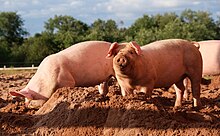| Pig | |
|---|---|

| |
| Domestic pigs | |
Domesticated
| |
| Scientific classification | |
| Domain: | Eukaryota |
| Kingdom: | Animalia |
| Phylum: | Chordata |
| Class: | Mammalia |
| Order: | Artiodactyla |
| Family: | Suidae |
| Genus: | Sus |
| Species: | S. domesticus
|
| Binomial name | |
| Sus domesticus Erxleben, 1777
| |
| Synonyms[1] | |
The pig (Sus domesticus), also called swine (pl.: swine) or hog, is an omnivorous, domesticated, even-toed, hoofed mammal. It is named the domestic pig when distinguishing it from other members of the genus Sus. It is considered a subspecies of Sus scrofa (the wild boar or Eurasian boar) by some authorities, but as a distinct species by others. Pigs were domesticated in the Neolithic, both in East Asia and in the Near East. When domesticated pigs arrived in Europe, they extensively interbred with wild boar but retained their domesticated features.
Pigs are farmed primarily for meat, called pork. The animal's skin or hide is used for leather. China is the world's largest pork producer, followed by the European Union and then the United States. Around 1.5 billion pigs are raised each year, producing some 120 million tonnes of meat, often cured as bacon. Some are kept as pets.
Pigs have featured in human culture since Neolithic times, appearing in art and literature for children and adults, and celebrated in cities such as Bologna for their meat products.
- ^ Groves, Colin P. (1995). "On the nomenclature of domestic animals". Bulletin of Zoological Nomenclature. 52 (2): 137–141. doi:10.5962/bhl.part.6749. Biodiversity Heritage Library